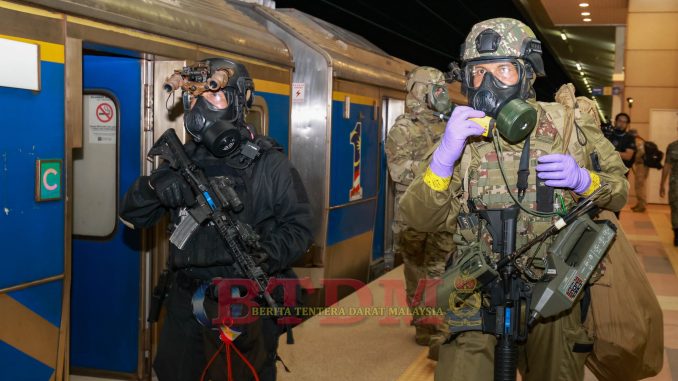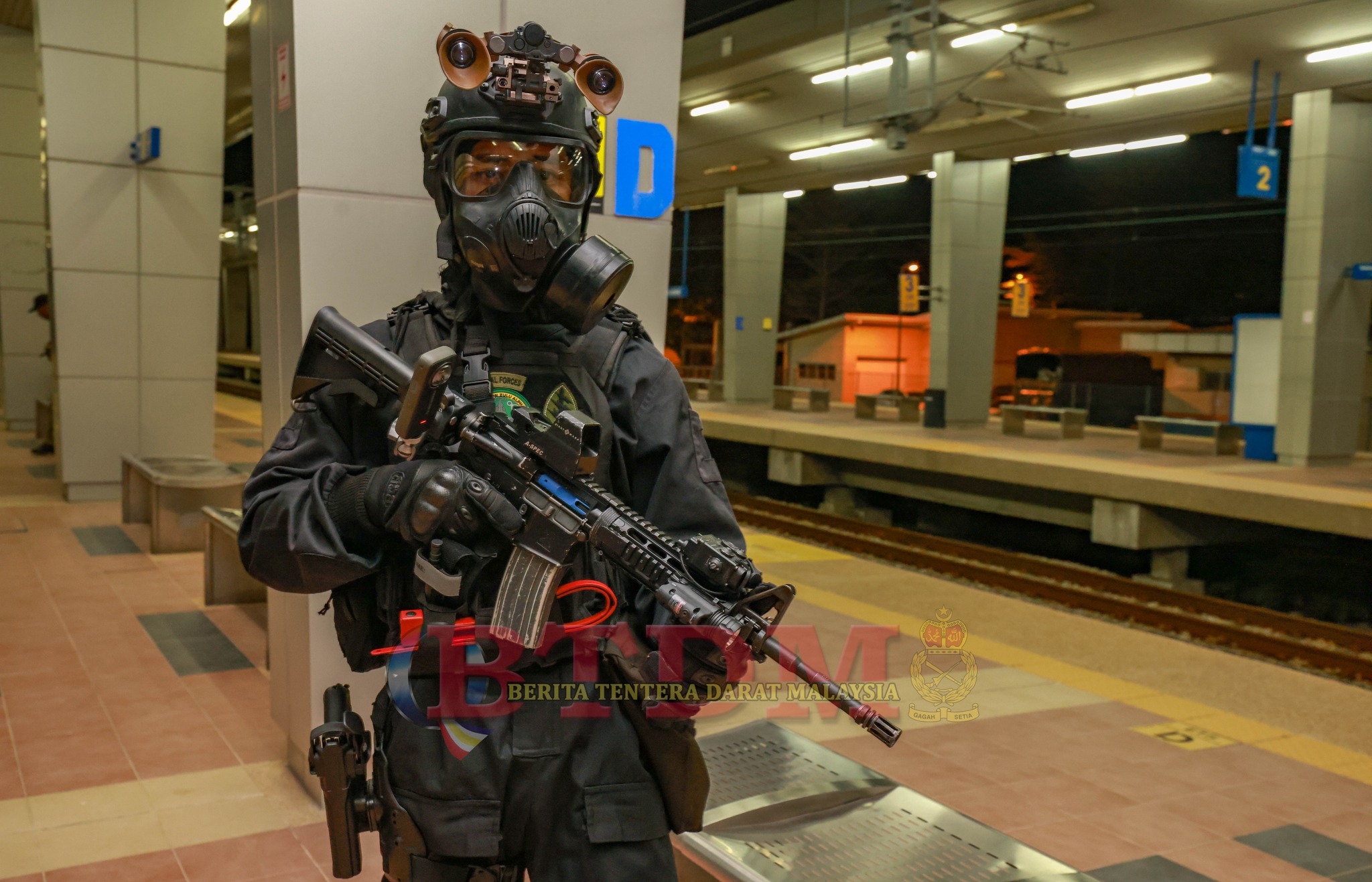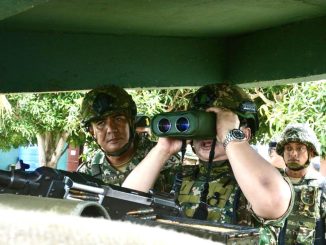
SHAH ALAM: IN the article for the supply of 45 e-bikes for the Army, Malaysian Defence wrote that the items being sought may well be electrified scramblers. However based on the sole bidder price for the items, it appears that these may well be electrified bicycles instead.

Yes, an electric scramblers may well be more suited for border patrol work but I am guessing that the allocation to Ordnance Department was too low for those higher-end machines. For recap, the department issued three separate quotation notices for the supply of 15 e-bikes or 45 in total for the Army for use in the northern peninsula, Sabah and Sarawak. The notice was published on Eperolehan, on March 12 and closed on March 19.

It is likely the sole bidder had quoted the same cost for each of the three notices, which were RM491,055. This make each e-bike cost around RM33,000 each. Way too low for an electric scrambler though quite pricey to road legal scooters which costs around RM8,800 in Malaysia.
As pointed out in the previous post, while electric bicycles may well be suited for urban setting, patrolling on one in the border areas – in full gear – may not be practical. The only positive part about using electric bicycles is the fact that if the batteries ran out, one could always pedal home back to the base.

As for the NVGs also sought for units operating in northern peninsula, Sabah and Sarawak, ten bidders has been shortlisted for each of the three notices. It is likely that the same companies are taking part in the competition as the bid prices are the same for each one.
The lowest bid for the three notices was RM246,000 which is likely a China made NVG. Most of the bids ranged from RM432,000 to RM497,449 which make me to believe that the cost estimate for each notice is RM500,000.
The highest bid was RM552,000. To recap, the three notices was for six NVGs each or 18 in total.
— Malaysian Defence
If you like this post, buy me an espresso. Paypal Payment



ridiculous beyond comprehension….
@Marhalim
FYI
On the iphone, clicking on your article, goes to the Arquus advert…its happening again.
So from E Scramblers down to E Mountain bikes? Me thinks maybe its for the staffers to ride around the bases since its too tedious to walk around.
What at waste of money, that could have paid for additional 6 more sets of NVGs which would have made more sense.
There are pro and cons of having electric mountain bikes instead of electric scrambler motorcycles.
getting electric mountain bikes means everyone can operate it, not restricted to those having motorcycle driving licenses.
it should also be of much lighter weight, which makes it easier to use smaller jungle trails, or having to carry it on your back on short distances over obstacles, rivers, boulders etc. Also the fact that it could be pedaled if the battery runs out.
the cons would be not road legal, small load allowance, wheel and tire strength, speed.
https://www.youtube.com/watch?v=JuZYO9vgY9o
If anyone could ID the Thales NVG in the pic much appreciated. Also appears we’ve replaced the Avon S-10 mask.
Also, prior to the Accuracy International L96 we got in the 1990’s what was the issue sniper rifle? The Enfield L42? Any idea Kel? Nothing to do with understanding what’s “low intensity” BTW.
Some people said it is the Thales Nellie NVG.
I am not sure whether it was the standard sniper rifle, I saw the Parker Hale sniper rifle with a RAMD batallion – could not remember what unit or the actual type, may well be the M85. The soldiers said it was the unit sniper rifle. Wikipedia said the M85 was used by Paskal though I never saw it on them, not saying that the the gun was not issued to the unit. The M85 lost to the the AI in the trials
Like with Eryx and the Milkor we bought the L96 specifically for Bosnia but later batches were added. A few years ago we bought a new rifle from Accuracy International to replace the L96.
I’m very curious what rifle we has in the 1980’s and whether it was the Enfield L42 which the Brits also relied on until getting the L96.
I think we bought Parker Hales of various versions instead of the Enfields…
As far As I know we have these : AI L-96s, AI AX308s, HK MSG-90A1 and Sig Sauer Blaser Tactical II [Army]; AI L-96 and Parker and Hale [RMN]. Unless I’m mistaken the most prolific rifle in the army was the L-96; replaced by the AX308. I had no idea the army had/has Parker and Hales. I do know however that only selected battalion’s have a sniper platoon.
Its not really a sniper platoon but the recon unit. There is also the counter recon unit. Most infantry batallion have these, RAMD AFAIK. Not sure about rangers though.
As far as I know during the 1990’s a number of battalions had a sniper element under the direct control of battalion HQ. 10 Para’s snipers I assume would not be limited to the Pathfinders.
Also, I have no idea if the army actually has a “sniper school” per say or is it a case of various units running their own sniper courses.
the Army training command had posted last year about a recon and sniping training at its facility in Port Dickson. Though most are done at unit level.
Even the British army due to funding had to close its NCO school some years ago but is establishing it again. Do we have an NCO school?
Technically only the MAF would have snipers and possibly VAT 69. Other police units and the MMEA would have “marksmen” who are not trained for field craft.; as opposed to “snipers” who are.
Yes, we do it is located at the Army training college in Port Dickson. Though unlike the officers training, not much spotlight is given to it which the reason, I am not sure what kind of training is provided for the NCO.
PULADA has a branch for training snipers & recce personnel.
It is called Cawangan Sniper dan Tinjau (CST Infantri)
All BIS battalions have a sniper section and a recce section embedded into the support company.
https://pbs.twimg.com/media/GKFXzHQaEAAFt11.jpg
So what does a BIS battalion’s Support Company comprise of as per on paper authorised set up? AT platoon [traditionally with Carl Gustav], MG platoon [GPMGs], mortar platoon; sniper section and recce section – quite a bit. 60mm mortars would be a platoon asset and I have to question why there is a need for them when the Milkor is available to lay HE, smoke and illum; albeit at shorter ranges.
In the future if we ever get loitering munitions it should be a company asset rather than a Support Company asset which is distributed on an ad hoc need basis. Decentralisation and flexibility. The downside as the Ukrainians and Russians have discovered is that adding loitering munitions equals to more men; men who are needed to operate and maintain/carry the loitering munitions. Manpower is an important issue as it’s something we don’t have in abundance; the army is a small volunteer force and various units will be below authorised strength. Each battalion should have an authorised strength of around 6/700 men and of that at least 30/40 percent will not be combat elements.
BIS on paper support company orbat
– antitank platoon
– HMG platoon
– mortar platoon
– assault pioneer platoon
– signals platoon
– reconnaissance section
– sniper section
Loitering munitions…
Should we put it under infantry company, needing them to multitask direct assault with soldiers and at the same time operate FPV drones?
Or we create a dedicated FPV regiment (say under RAD as a rejimen bantuan rapat) that is 100% dedicated to FPV drone mission? As this things have 5-10km range, it can be an addition to, or as a substitute to RAD 105mm howitzer regiments.
”– HMG platoon”
Surely you mean ”GPMG” platoon.
”soldiers and at the same time operate FPV drones?”
As I said; there will be more people to operate/handle the UASs and loitering munitions. Just like how it’s an accepted fact that there are people in a unit who do nothing but operate mortars or GPMGs.
”Or we create a dedicated FPV regiment (say under RAD as a rejimen bantuan rapat)”
You have a penchant for centralising things. Under a ”dedicated FPV regiment” would the capability be there; when needed by those who need it; when they need it? You’ve often made references to the Ukrainian war; well successes on the part of the Russians and Ukrainians have been possible because things were organised in a decentralised and flexible manner; i.e. UASs and loitering munitions organic to small units. Same reason why counter battery radars and UASs must not be hogged by Brigade or Divisional HQs but at minimum at Regimental or even battery level.
”or as a substitute to RAD 105mm howitzer regiments.”
As has been explained; as much as it’s tempting to suggest; loitering munitions can’t be a substitute for arty or mortars. They aren’t as responsive and are affected by rain/sand/snow storms and low clouds. They complement; not replace other things.
….
Here’s one for you. Prior to us getting the South Korean heels under PERISTA we only had a handful of HMGs; tripod mounted which for obvious reasons we used for static defence. Fast forward a decade or less we started buying more as mountings for various armoured vehicles [up to then pintle mounts on vehicles were fitted with the MAG 58 and prior to that the M1919 “30 calibre”].
Then we also mounted the M2 on the G-Wagon and Vamtac. I would like to know who owns these G-Wagons and Vamtacs armed with M2s, Mk19s and mini guns? Are they issued to specific companies or do they belong to the Support Companies and are they only to be found in BIS battalions?
Something else on a subject we discussed in the past : CAS and joint air controllers. The RMAF trains for interdiction and ground attack but not CAS. Interdiction and ground attack [which we did on several occasions during the 2nd Emergency and Operation Daulat are not CAS]. We naturally assume it does but it actually doesn’t and many would be surprised as to how many air arms actually don’t perform CAS. The laser range finders used by PASKAU are for lasing targets behind enemy lines but not CAS per see.
… – “signals platoon”
This is surprising as the signals element should be under battalion HQ and not the Support Company. Doesn’t sound right. The sections have their own radios which are on the company net and companies are on the platoon net. Battalion HQ has contact with all its sub units and also with Brigade net. Why on earth is a “signals platoon” within the Support Company? If anything it should be a “signals section” not “platoon”.
I have also no idea why the “assault pioneer platoon” [I know what “pioneers” are – German term – but what are they doing here];
“reconnaissance section” and “sniper section” are under the Support Company as not all of these are “support” functions per see and make the Support Company extremely unwieldy. One can also have a “recce/scout section” with an integral sniper or sharpshooter element. Note that during the 2nd Emergency units had a “strike unit” [the Rangers pioneered it] which later led to
“Unit Combat Intelligence Squads” but these were not under the Support Companies.
” Surely you mean ”GPMG” platoon ”
GPMG is an Infantry Company-level asset in the BIS orbat, not Support Company.
” I would like to know who owns these G-Wagons and Vamtacs armed with M2s, Mk19s and mini guns? Are they issued to specific companies or do they belong to the Support Companies and are they only to be found in BIS battalions? ”
They belong to Support Companny in BIS battalions.
” CAS and joint air controllers ”
A reason why I have suggested previously for PASKAU to drop missions that is also been done by other units (such as hostage rescue or other general commando ops) and take up the JTAC mission. Precisely communicating with multiple airborne assets such as LCA, MRCA, AEW&C to strike time sensitive targets near to friendly troops is a skill not many units have (if any). PASKAU as the same service as the fighter pilots up in the air would understand and trust the JTAC on the grund to guide them to the correct target at the correct moment in time.
https://www.youtube.com/watch?v=ukNLcRGvRjg
” Under a ”dedicated FPV regiment” would the capability be there; when needed by those who need it; when they need it? ”
Have you tried to fly a FPV drone?
Can you move around, run from hide to hide while your eyes are enclosed with a FPV Goggle, while being shot at by the enemy?
https://pbs.twimg.com/media/GKSMx8Xa0AE2l3W.jpg
You need to sit still throughout the flight of the FPV drone up till it hits the target. That would be the longest 5-10 minute of your life.
Not to mention the FPV drone preparation time before the flight itself. Can anyone do that while moving with an infantry squad/platoon/company towards an objective?
I am okay for company-level infantries to have line-of-sight weapons, like GPMG, RPG-7, or even Carl Gustaf M4. FPV drones that usually attack targets BLOS (beyond line of sight, the target, not the drone itself) does not need its operators to be running along together with infantries on the frontline. It can be a dedicated FPV drone company, that can search and acquire targets on its own.
https://www.reuters.com/world/europe/ukraines-zelenskiy-orders-creation-separate-military-force-drones-2024-02-06/
Bosnian Air Force JTAC (Joint Terminal Attack Controller) special forces development program, supported by US Special Operations Command Europe
https://www.youtube.com/watch?v=lddOgXOFbvI
” Why on earth is a “signals platoon” within the Support Company? ”
That is what the army wants. Signals is a support function, and is put under the Support Company. Personnel of this platoon is mainly be at the battalion HQ, but will parcel out to operational infantry companies.
https://pbs.twimg.com/media/GKSjAGIbQAAO82r.jpg
” I have also no idea why the “assault pioneer platoon” [I know what “pioneers” are – German term – but what are they doing here] ”
Assault Pioneer or in Tentera Darat parlance – RINSER (Rintis Serang) is a team supporting other infantry movements by building bunkers, defensive positions, demolitions, demining and also setting up posts and first aid stations. It is also considered as a support function within the BIS battalion, so it is put under the Support Company. The crown prince of Selangor, Tengku Amir Shah is currently the Platoon Leader for the RINSER Platoon of 17 RAMD.
https://pbs.twimg.com/media/GKSjAGJaAAAhCkf.jpg
“ Have you tried to fly a FPV drone”
Much harder than a UAS. Requires a much higher level of skill. I assume you have?
You operate your FOV drone a distance away; not whilst you’re under direct enemy fire. Look it up. Who’s asking for FPV operators to “run around” with the infantry? You’ve completely missed the point I was driving at. Having them organic to infantry battalion does not mean they are directly in the line of contact. Anymore than a mortar crew would be exposed to direct fire. Like I said; whether with the Russians or Ukrainians the reason they’ve had the success they’ve had is because FPV drones are organic to them. They have the capability without having to rely on others; like they do with mortars and other indirect fire weapons. Whether a FOV drone or a DJI they are complementary to existing assets; having them operated by a separate formation is centralisation which equals to inflexibility and is a recipe for ensuring those who need it won’t get it in time.
As for CAS and PASKAU I know you’ve suggested a lot of things and posted a lot of obligatory links but the point I was making was not the unit’s inability to do it but the fact that the RMAF does not train to do it.
In mechanised unit, the signals company is attached to the JLJ unit attached to the batallion. Probably it because the JLJ technicians to maintain them as well.
Being able to provide direct support does not mean UAS or FPV drone operators have to be up alongside troops and exposed to direct fire. They operate their systems a distance away; yes they may be exposed to indirect fire and even to enemy loitering munitions or UASs but they are on the line of contact per see. Same with the crews of any other crew served weapon.
” I assume you have? ”
Yes I have. It is quite disorienting if you are not familiar with the flying area. You really need to know/remember the landmarks around your flying area not to be disoriented.
Feel free to disagree but I still feel that a unit specifically tasked to fly FPV drones is better than having infantry companies flying them.
” RMAF does not train to do it ”
Of course, currently it is not trained to do it. But it needs to in the future. Right now it is doing stuff that is similar other special operation forces in malaysia is doing, when there are fundamental capabilities of an Air Force such as JTAC that is simply not there. Still not too late to change tack and have PASKAU learn the knowhow to do JTAC missions.
… – Yes I have”
Kudos! Acclaim. Which is why it’s been found that it’s inherently harder to train a FLV operator than a UAS one; the Ukrainians have discovered the same thing as part of their “Army Of Drones” programme.
… – “Feel free to disagree but I still feel that a unit specifically tasked to fly FPV drones is better than having infantry companies flying them”
I’m not only free to disagree but will and have told you why. The Ukrainians and Russians also apparently see things the same way.
Also since you’ve missed the point the intention is to have the capability organic to the battalion or company for reasons well known : flexibility, faster decision making, ensuring they have it when they need it. It’s not 1917 or 1815 anymore. Also it not the the riflemen of companies who fly them as you put it but people whose job is to operate them – note the nuance. Just like how within a battalion or company there are people whose job is to do specific things.
thank
Also as pointed out like mortar crews loitering munitions operators are not up in front “running around” with the infantry; as you put it. They operate hundreds of metres away from the point of contact. Look it up in a link.
Irrespective of your “off course” it’s downright daft to have PASKAU practice calling in CAS if the RMAF – like various others – does not perform CAS. Also there is a slight difference with what it does and what other SF units do.
” The Ukrainians and Russians also apparently see things the same way ”
Zelenskiy did not get you memo…
https://www.reuters.com/world/europe/ukraines-zelenskiy-orders-creation-separate-military-force-drones-2024-02-06/
” Irrespective of your “off course” it’s downright daft to have PASKAU practice calling in CAS if the RMAF – like various others – does not perform CAS ”
RMAF also seems to miss your memo…
https://www.airforce.mil.my/index.php/bm/informasi/berita/berita-utama2/mawilud-1-melaksanakan-latihan-air-to-ground-electronic-warfare-close-air-support-dan-eks-jaguh
” They operate hundreds of metres away from the point of contact ”
I don’t want to put out TD doctrine out here but, when deployed as a company, everyone in the company fights together, not piecemeal. 60mm mortar crew within a BIS infantry company consists of just 3 person manning 1 mortar (with another 3 person using GPMG to complete the support section for the company), to fire at enemies within line of sight.
https://www.malaysiandefence.com/wp-content/uploads/2021/09/60mm1.jpg
FPV drones have their own cameras to look at the target, not needing Mk1 eyeball to have a direct sight of the target. Would just 3 person to operate FPV Drones within an infantry company useful operationally?
… – “zelensky”
That’s you being selective and obnoxious. I was referring to unmanned systems at a lower level. At battalion. Realise the difference? Also, UASs at a certain level should be operated by a joint command, hence my mention of what Ukraine and South Korea have done and what the SAF has long done. Hence my preference for MALES to be operated by a joint command but the discussion was in unmanned systems at a lower level.
If you have this insatiable desire to cherry pick at least stick to the script.
… – “RMAF”
Stuff your “memo”. I merely said that PASKAU does not call in CAS because the RMAF does not perform CAS. Self explanatory.
Thanks for the customary and obligatory links but stick to the right script instead of deviating. Ask any RMAF pilot if they train fir CAS. You do know the difference between CAS and ground attack/interdiction do you not or do you need a link to help you? You are able to think for yourself rather than relying solely on links are you not?
“60mm”
The operators of crew served weapons do not expose themselves to direct fire. As such your claim that FOV operators would have to “run around” with infantrymen is nonsensical.
Who said.anything about 3 people? You would need more than 3 people to operate and maintain x number of loitering munitions at battalion level.
You saying it is not does not change the hard facts with proof.
I understand why you dislike when facts are put in front of you, They contradict your narrative.
And now you are changing your narrative to loitering munitions at battalion level when originally you say it should be parcelled down to infantry company level.
I don’t really care what your narrative is, its your call. But telling my opinion is wrong? Are you the absolute army authority or what?
.. – ”everyone in the company fights together, not piecemeal”
Did anyone say or imply otherwise? If so; when and where? Does me mentioning that operators of crew served weapons; like loitering munitions and UAS operators; operate some distance behind the line of contact indicate anyone operating ”piecemeal”? Why don’t you mention the earth is not flat whilst you’re at it?
As it stands the Ukrainians like others will have a joint UAS command which is highly essential in this day and age and is not merely because several entities have the same capability as you confidently but mistakenly claimed [get a link and look it up]. At a lower level – which is what the discussion was centered on – UASs and loitering munitions will be operated and owned by the units who are using them. This enables a faster decision making process and flexibility; ensuring those who need the capability get it when they need it as opposed to relying on someone else. Decentralisation. It’s not the Punic or the Napoleonic wars anymore but 2024.
𝐄𝐗𝐄𝐑𝐂𝐈𝐒𝐄 𝐁𝐄𝐑𝐒𝐀𝐌𝐀 𝐒𝐇𝐈𝐄𝐋𝐃 𝟐𝟎𝟐𝟒 – 𝐓𝐔𝐃𝐌 𝐔𝐉𝐈 𝐊𝐄𝐒𝐈𝐀𝐆𝐀𝐀𝐍 𝐀𝐒𝐄𝐓 𝐃𝐀𝐍 𝐀𝐍𝐆𝐆𝐎𝐓𝐀 𝐃𝐀𝐋𝐀𝐌 𝐋𝐀𝐓𝐈𝐇𝐀𝐍 𝐂𝐋𝐎𝐒𝐄 𝐀𝐈𝐑 𝐒𝐔𝐏𝐏𝐎𝐑𝐓 𝐌𝐈𝐒𝐒𝐈𝐎𝐍
Objektif utama pelaksanaan latihan ini adalah bagi meningkatkan keserasian Juruterbang dan Controller dalam melakukan misi Close Air Support di dalam situasi yang dirancang ataupun tidak dirancang.
Latihan ini juga merupakan satu proses pembelajaran yang sistematik dan terancang yang memerlukan kepantasan serta kecekapan juruterbang dan controller apabila berkomunikasi pada setiap misi yang dilaksanakan melibatkan dalam tempoh masa yang singkat.
https://www.facebook.com/tudmrasmi/posts/pfbid0yo2CPueGdpY5oB157sX8FnjmhpZ4fS11PmPoQeAnPNbww7DpT5QjXvptNUh7ri4Wl
Thanks for the customary link.
Good luck to the RMAF because CAS is very skill intensive and the RMAF with the number of aircraft it has can only devote so much time to CAS. As it is stuff like anti ship and other mission sets are rarely performed because various other things come 1st in order of priority. BTW this is not the 1st time CAS has been added to a FPDA exercises; a previous one saw Brit controllers inserted in a jungle.
Prior to this – like many air arms – the RMAF practised for interdiction and ground attack but not CAS.